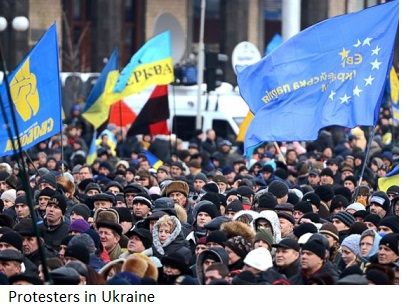 A politically divided and potentially more violent Ukraine highlights broad social, economic, and geopolitical orientations that will have long-range consequences. Currently Ukraine, as other countries in this post-Soviet area, has four socio-economic poles of attraction and options.
A politically divided and potentially more violent Ukraine highlights broad social, economic, and geopolitical orientations that will have long-range consequences. Currently Ukraine, as other countries in this post-Soviet area, has four socio-economic poles of attraction and options.
The first is participation in an emerging world society with no special links to regional groupings − a stand-alone policy. However, the globalizing market has only a few rules set by the World Trade Organization. This globalizing market is influenced by policies of the World Bank, the International Monetary Fund, and by the actions of private transnational corporations. A stand-alone State does not have the benefits or influence arising from membership in a regional economic association unless it has other strong cards in its hand, such as the case of Switzerland.
A second major pole of attraction is the European Union (EU) with which Ukraine had already some treaty agreements. The refusal by the then President of Ukraine, Viktor Yanukovich to sign a more detailed plan of action with the EU was the reason or a pretext for the start of the massive demonstrations in Kiev.
The EU itself faces important decisions concerning economic and political policies toward non-EU States. The EU is involved with a Mediterranean policy focused on North Africa and the Middle East. For the moment, activities are few due to uncertainty of the future of the North African-Middle East area after the changes in government in Libya and Egypt, continuing armed conflict in Syria, and very uneven relations with Turkey. Nevertheless, the Mediterranean option for the EU is important and requires constant diplomatic and economic attention.
Another focus of EU attention which can have important consequences is the ongoing negotiations on a free-trade agreement with the United States. All the elements of these negotiations have not been made public, although certain aspects concerning agriculture, cultural goods, and taxation have been discussed publicly. Although the nature of a free-trade agreement between the EU and the USA is not yet clear, it would have a world-wide impact. Thus the EU is in a period in which its major orientations will be set. The addition of new full members to the EU is unlikely.
The third policy option for Ukraine is for closer relations with the Russian Federation and a possible “Eurasian Customs Union” that could include Russia, Belarus, Kazakhstan, Armenia, Azerbaijan and perhaps Moldova and Ukraine. Such a Eurasian association would probably develop into more than a common market. However, the full structure and tasks of such a Eurasian association have not been discussed publicly.
The fourth policy option and pole of attraction is the wider Eurasian system of the Shanghai Cooperation Organization. The motor of the Shanghai Cooperation Organization is China, but it includes Russia and the Central Asian States of the former Soviet Union with Iran, India, Pakistan, and Afghanistan as permanent observers. The Shanghai Cooperation Organization began as a limited political agreement linked to Chinese fears of Islamic unrest in the Central Asian States and its impact on China, but its political and economic potential is great.
The current situation in Ukraine and Crimea does not lend itself to calm considerations of basic orientations or compromises which could include combinations of all four poles of attraction. Both EU and Russian diplomacy will weigh in the Ukraine decisions, and the USA and Chinese diplomacy is not likely to be absent. Regardless of the course that Ukraine takes, this is a situation to watch closely.
Rene Wadlow is the Representative to the United Nations, Geneva of the Association of World Citizens.
